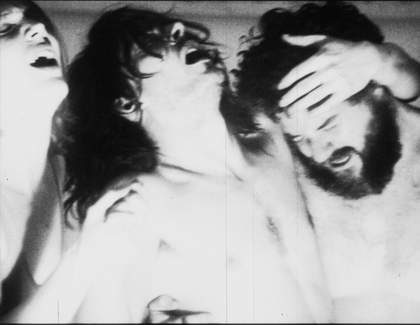Canadian-born, Berlin-based artist Jeremy Shaw joins us to present and discuss the UK premiere of his recently completed Quantification Trilogy, which imagines countercultural behaviours at three different points in the future.
The first film in the trilogy, Quickeners (2014), is set 500 years in the future and tells the story of Human Atavism Syndrome (HAS), an obscure disorder afflicting a tiny portion of the existing immortal species wirelessly interconnected through a central hive. HAS causes those affected to desire and feel as their human being predecessors once did: giving sermons, singing, praying, dancing, speaking in tongues, performing rituals with snakes and trying to reach ecstatic states.
Liminals (2017), the second film in the trilogy, is set three generations from today and unfolds as chapter cut from a future documentary about marginalised societies. With the discovery that the long-abandoned notion of faith had biologically evolved to become an essential aspect of human survival, a radical clandestine group augment their brains with machine DNA and re-engage forgotten cathartic spiritual rituals in the hopes of accessing The Liminal – a speculative paraspace between the physical and the virtual. It is here they prophesise that humanity will temporarily exist in gestation towards a new phase of evolution.
The final film, I Can See Forever (2018), is set roughly 40 years in the future and is structured as a documentary TV episode about the only known survivor of a failed government experiment that aimed to create a harmonious synthesis of human and machine. Born with 8.7% machine DNA, yet uninterested in the virtual reality trappings of his time, the 27-year old survivor has committed himself to a life immersed in dance. It is during his unique virtuosic activities that he claims to be able to transcend to a digital plane of total unity while maintaining a corporeal physical presence.
Programme
Introduction by the artist
Screening of Quantification Trilogy, Germany 2014–18, DCP, colour, sound, 111 min
Discussion and Q&A with the artist and Tate Film curators
Biography
Jeremy Shaw (b.1977, Canada) is a visual artist based in Berlin. His work explores altered states and the cultural and scientific practices that aspire to map transcendental experience. Often combining and amplifying strategies of verité filmmaking, conceptual art, music video, esoteric and scientific research, he creates a post-documentary space in which disparate belief-systems and histories are thrown into an interpretive limbo. Shaw participated in the 57th Venice Biennale (2017) and is the recipient of the 2016 Sobey Art Award. Solo exhibitions include Kunstverein in Hamburg (2018), Montreal Museum of Fine Arts (2018), The Store x The Vinyl Factory, London (2017), Schinkel Pavillon, Berlin (2013), MoMA PS1, New York (2011), and Museum of Contemporary Canadian Art, Toronto (2006).





